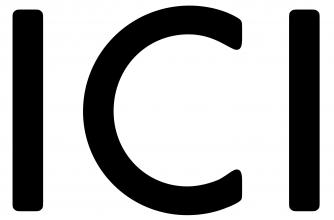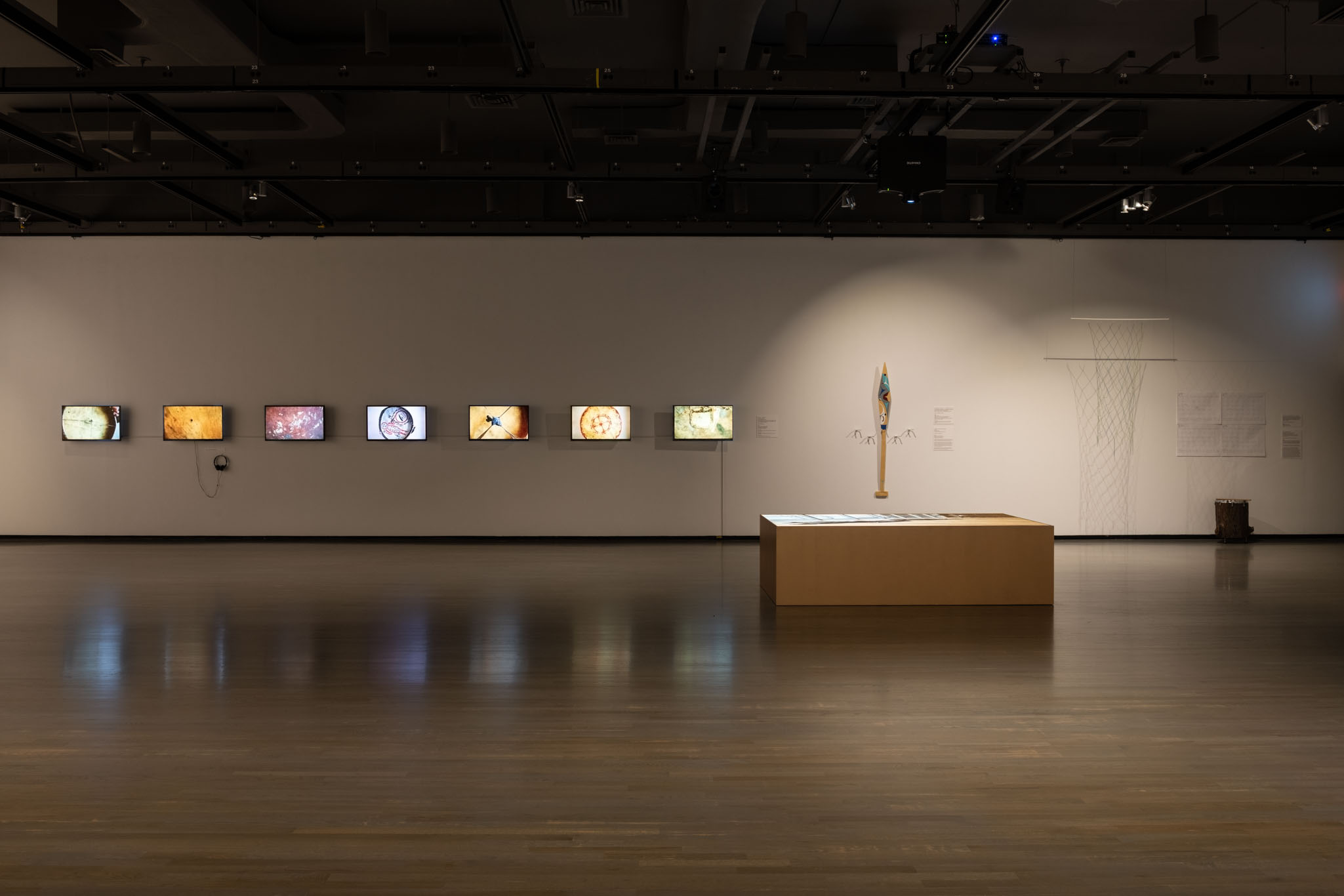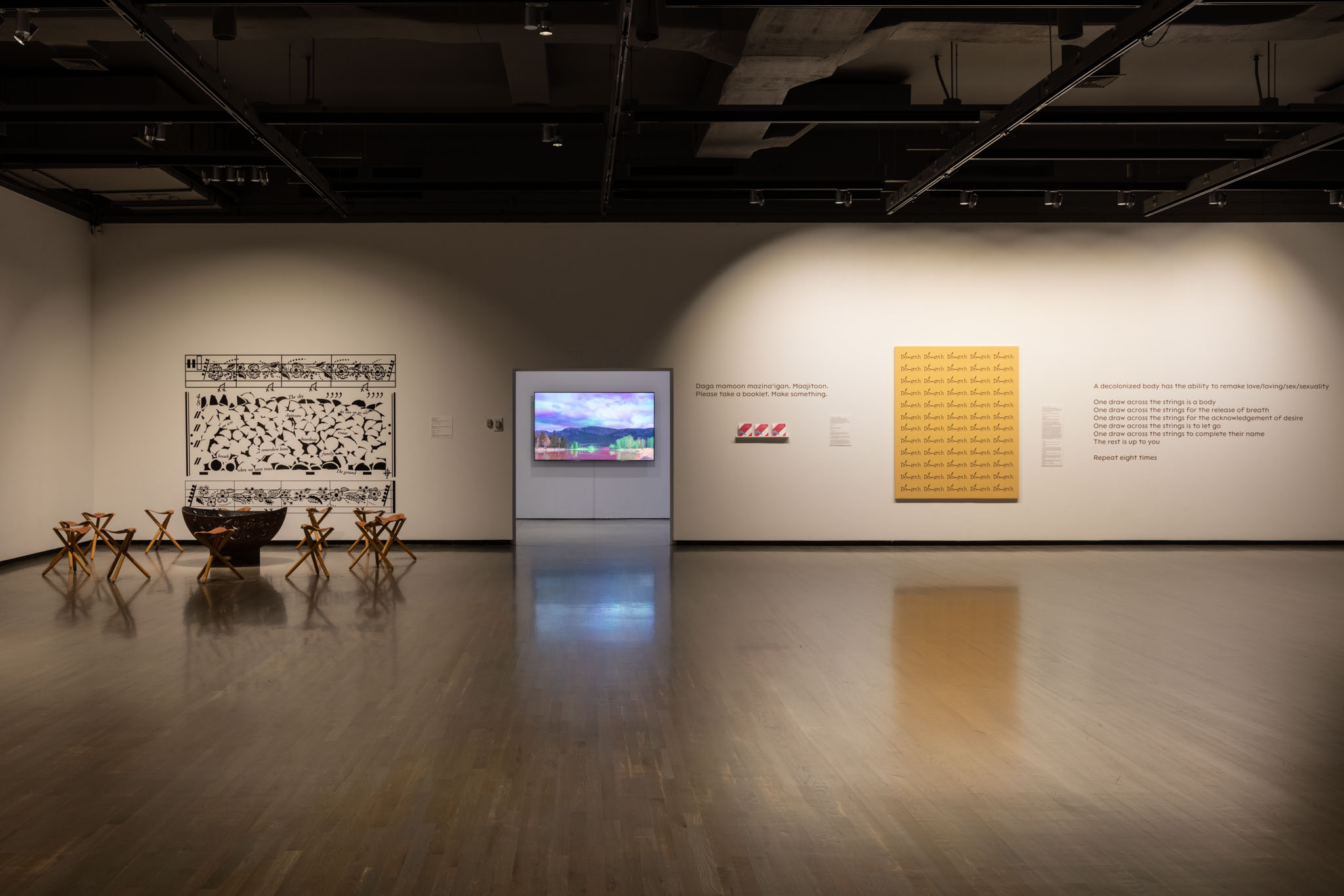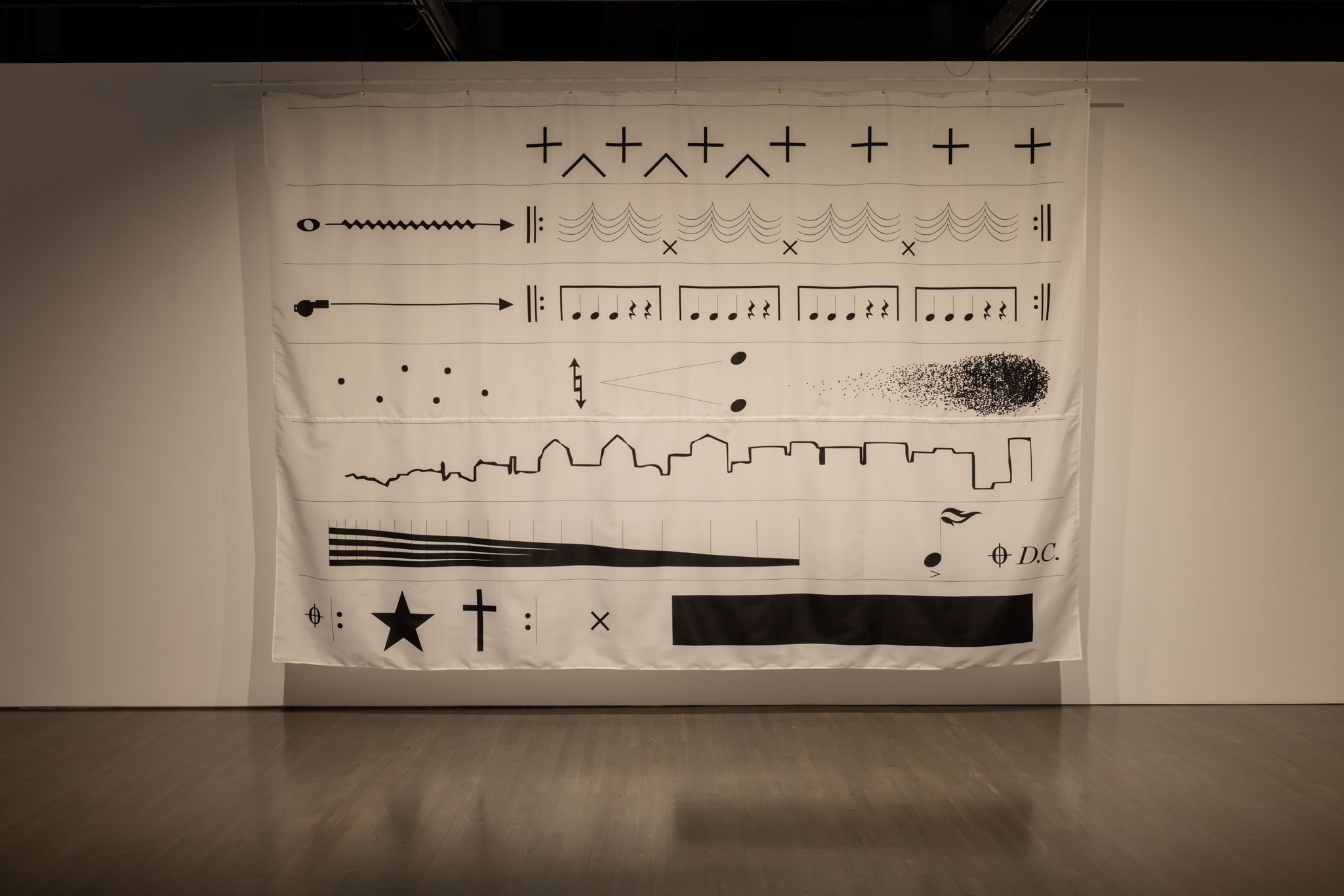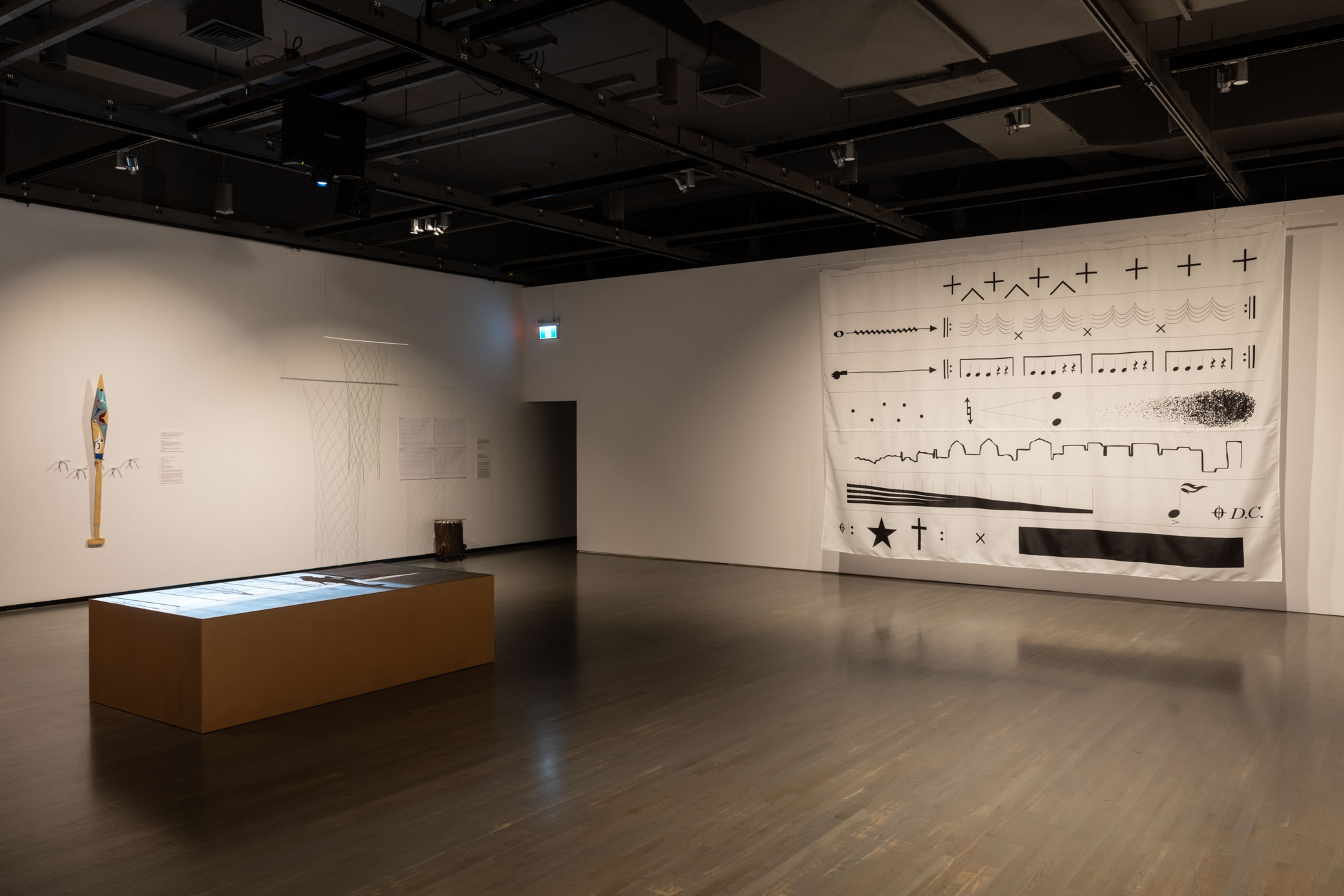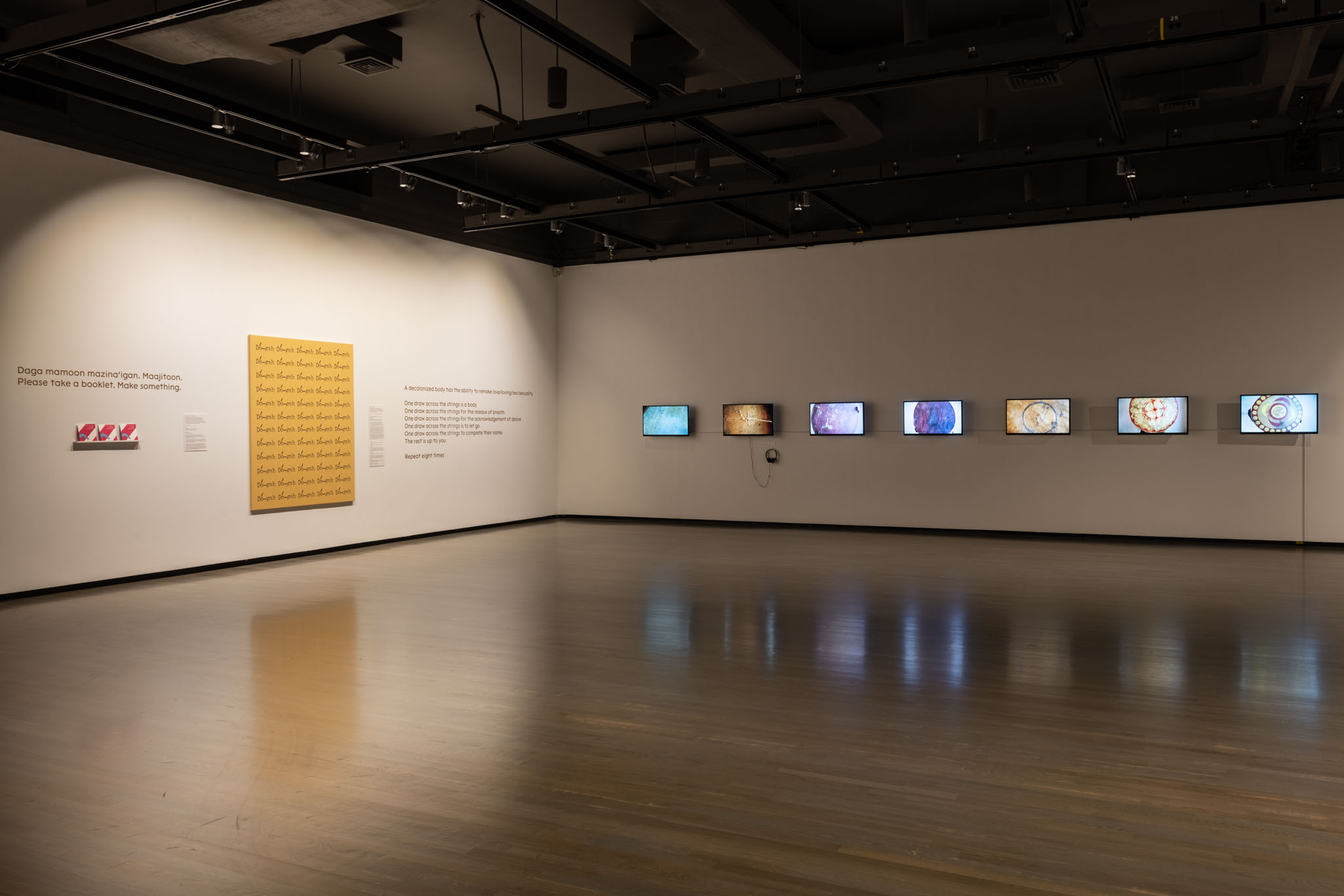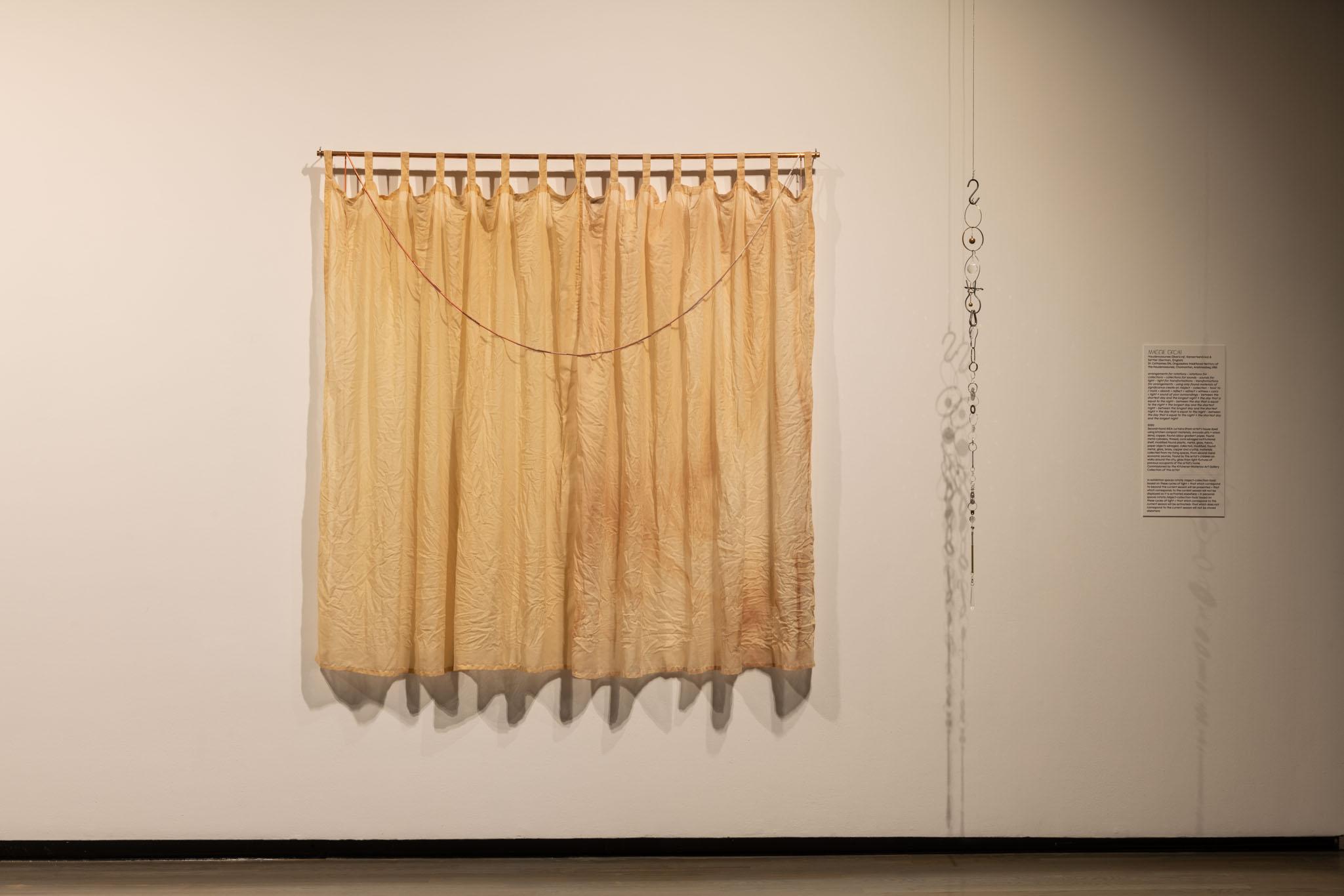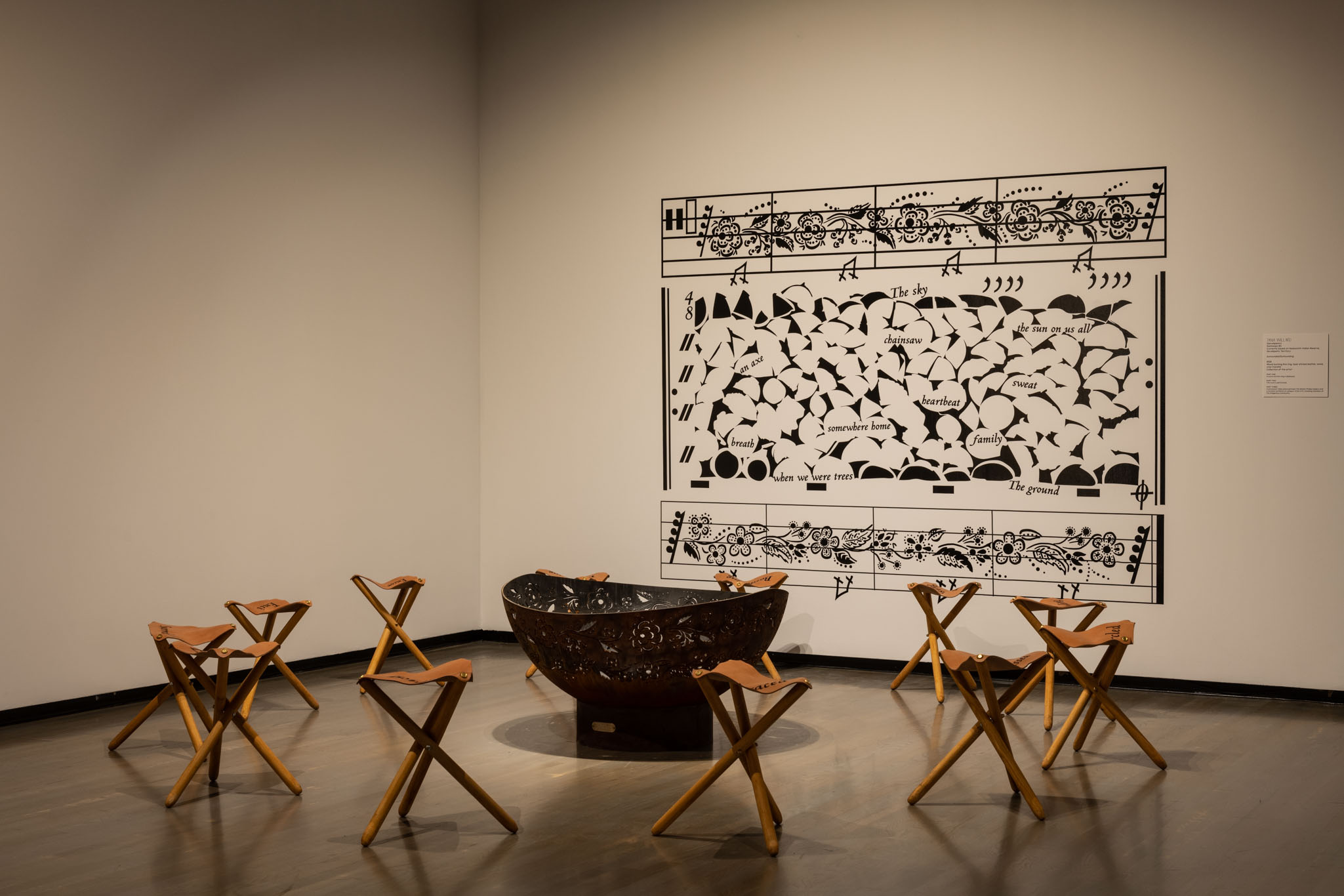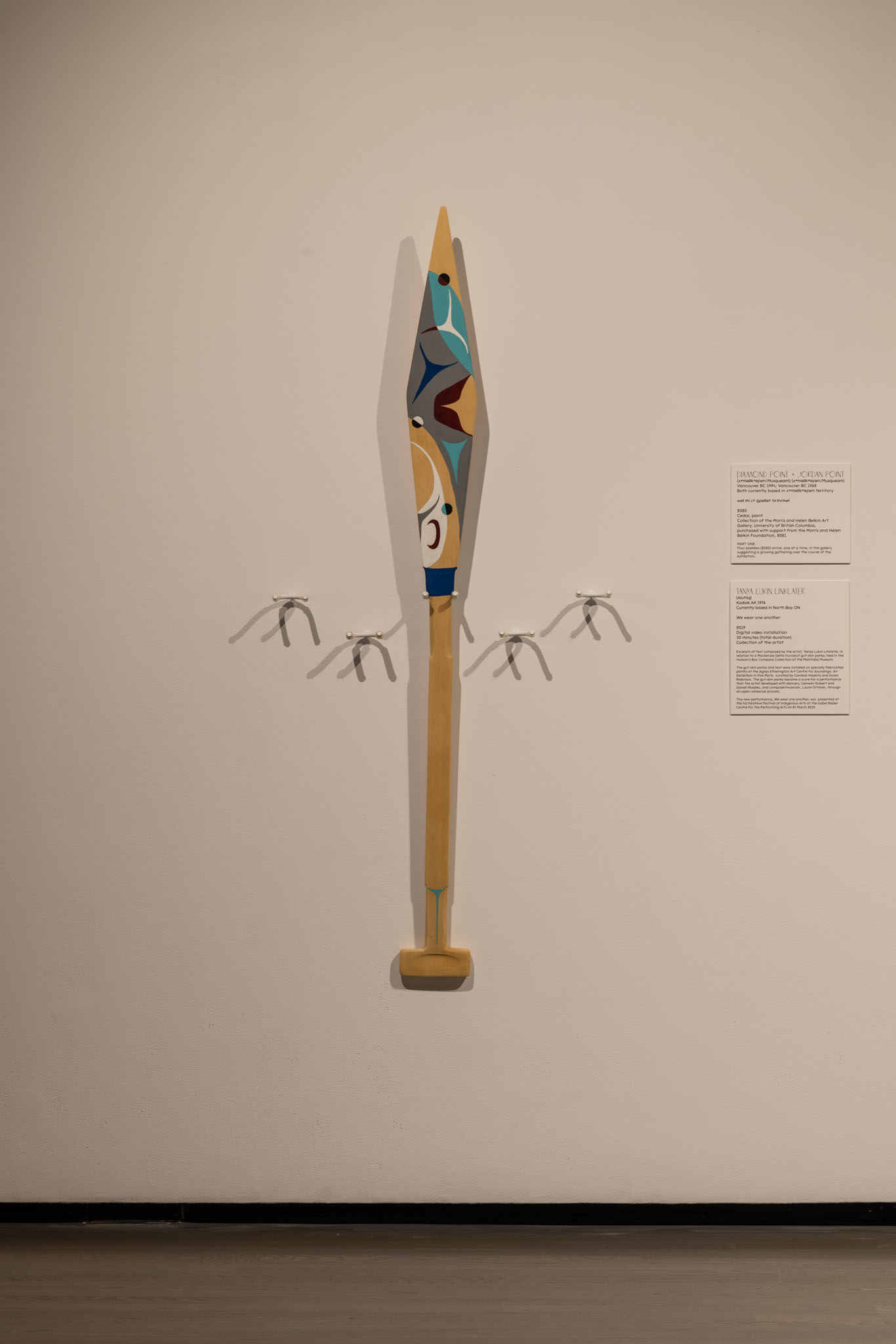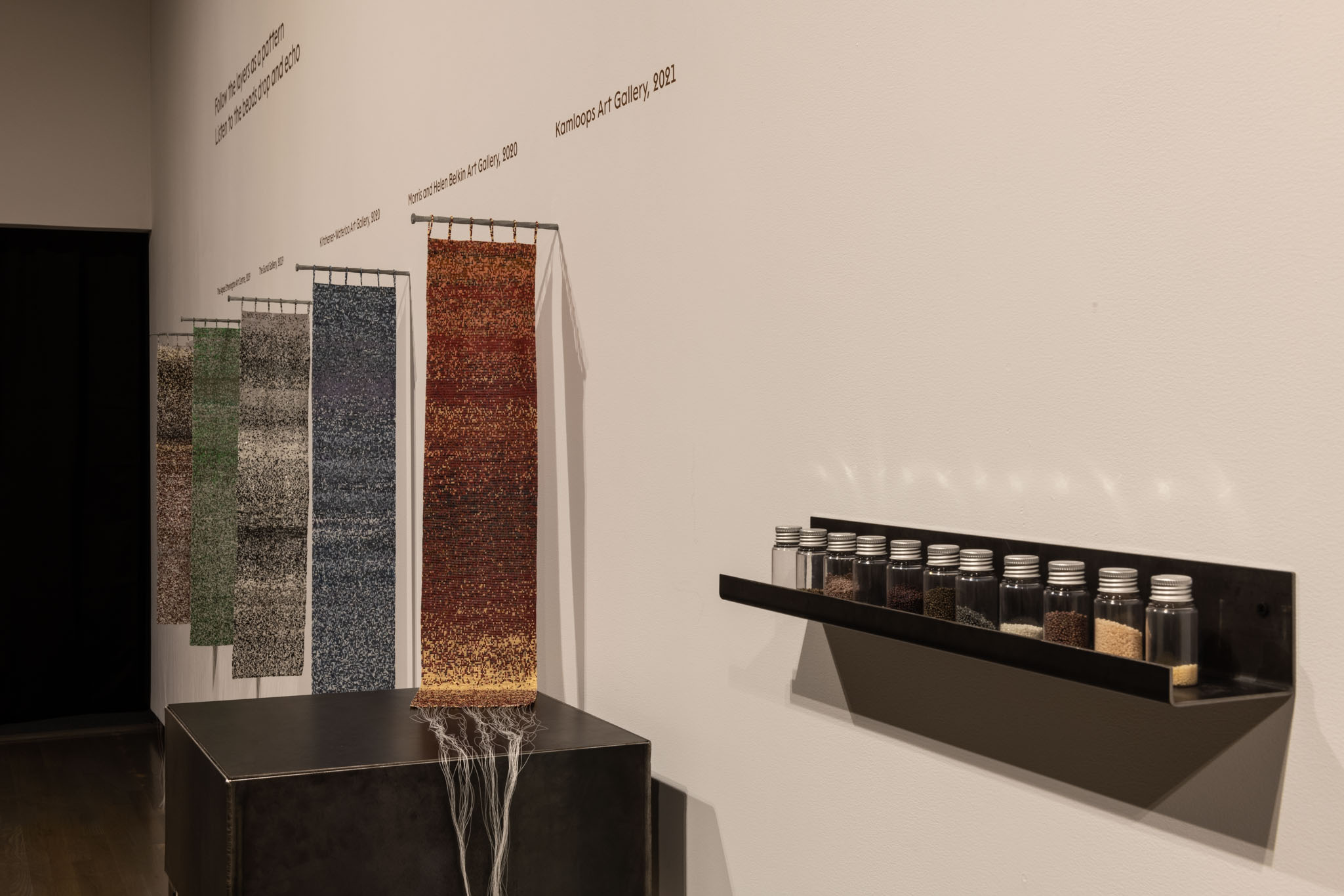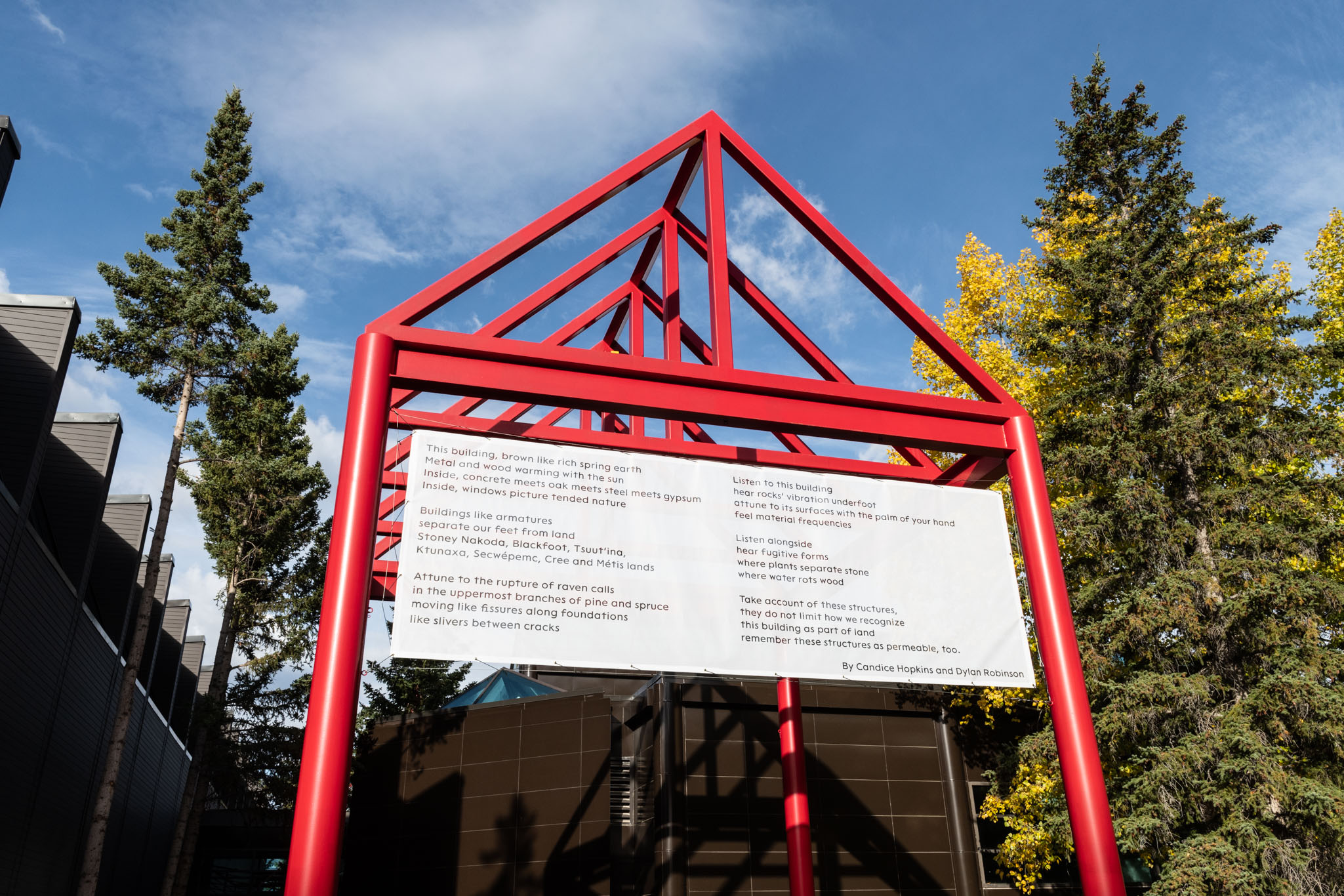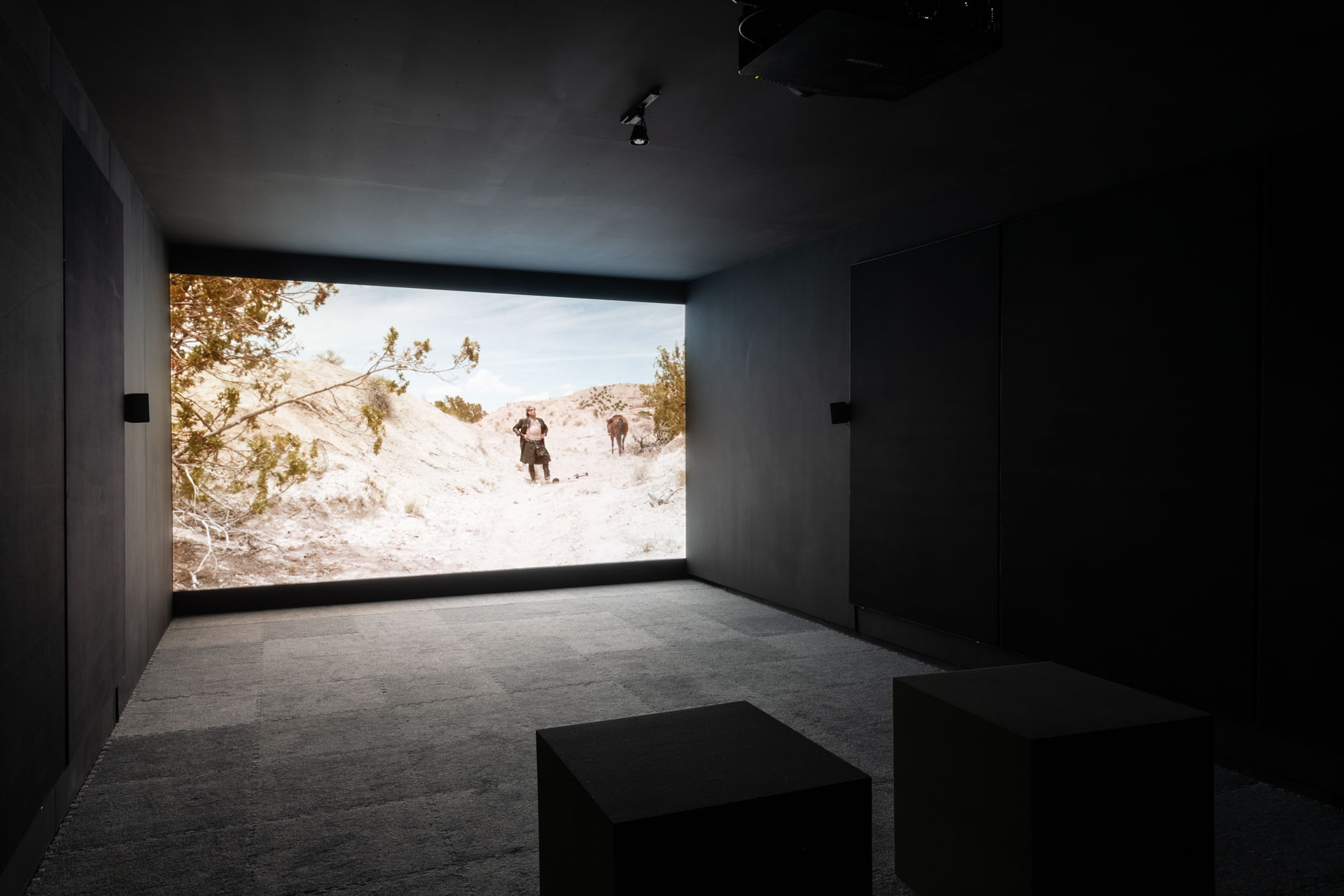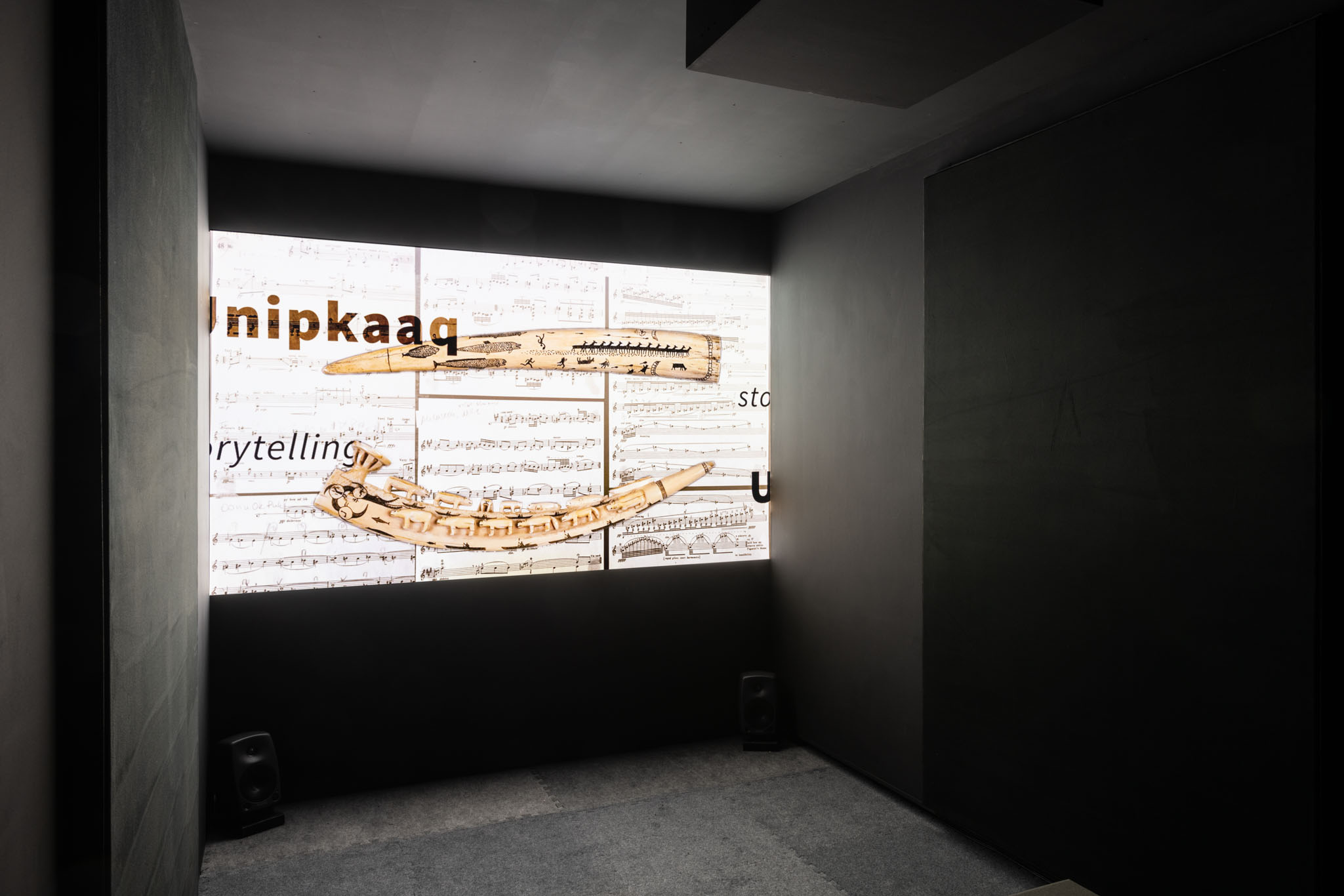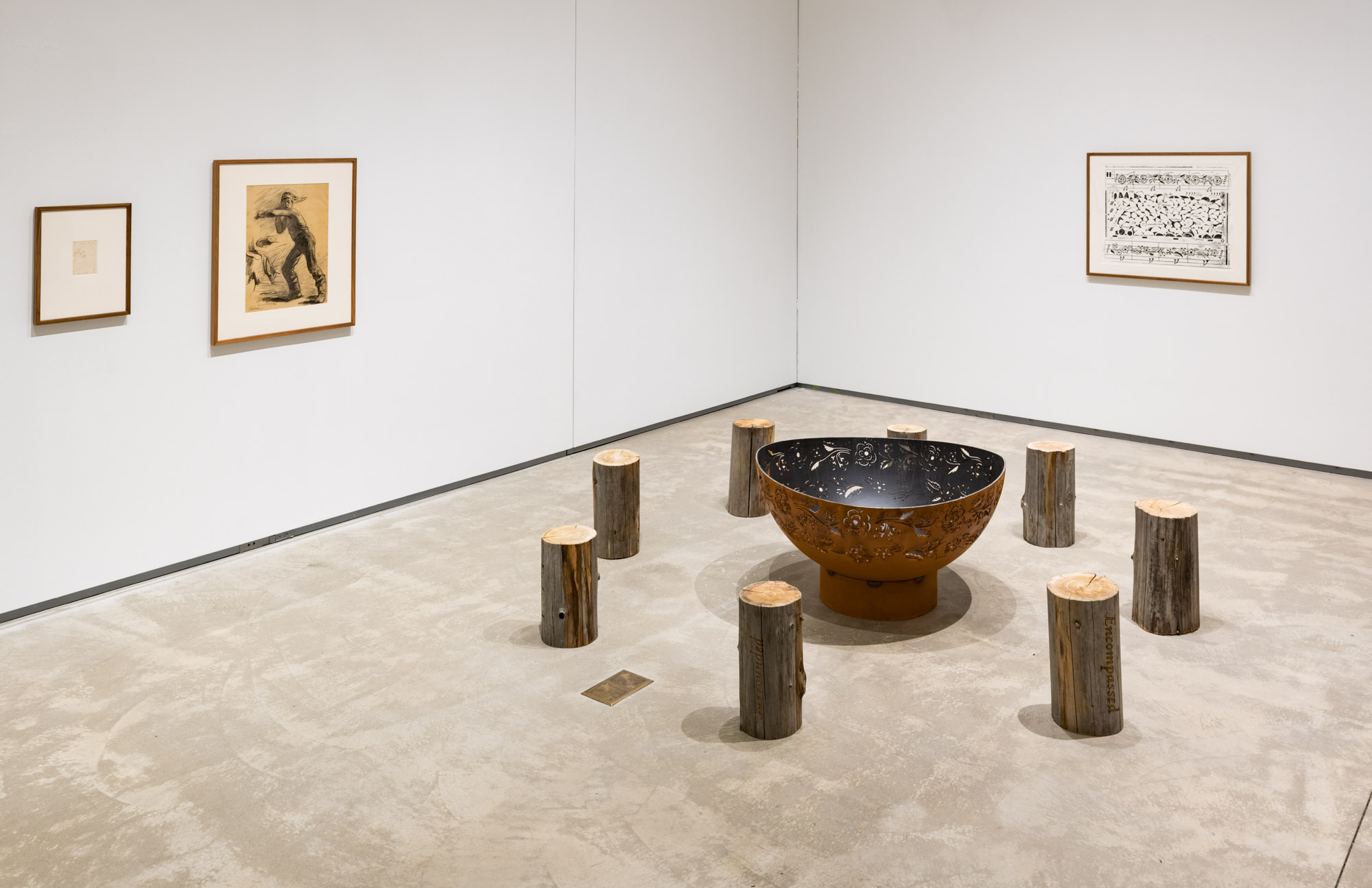
Tania Willard, 'Surrounded/Surrounding', 2018, wood burning fire ring, laser etched cedar woodlogs from SecwépemcTerritory, relief print on paper. Collection of the artist. Gifted to Four Directions Aboriginal Student Centre, Kingston, 2019. Photo: Paul Litherland
Soundings: An Exhibition in Five Parts
Curated by Candice Hopkins and Dylan Robinson
Exhibition tour organized by Independent Curators International (ICI)
September 10 - December 5, 2021
In-Person Exhibition Tours: November 12, and December 1
Gallery Hours: Wednesday - Saturday | 12:30 - 5:00
How can a score be a call and tool for decolonization?
Soundings: An Exhibition in Five Parts features newly commissioned scores, performances, videos, sculptures and sound by Indigenous and other artists who respond to this question. Unfolding in a sequence of five parts, the scores take the form of beadwork, videos, objects, graphic notation, historical belongings, and written instructions. During the exhibition, these scores are activated at specific moments by musicians, dancers, performers and members of the public gradually filling the gallery and surrounding public spaces with sound and action.
The exhibition is cumulative, limning an ever-changing community of artworks, shared experience and engagement as it travels. Soundings shifts and evolves, gaining new artists and players in each location. Some artworks have multiple parts, others change to their own rhythm as the exhibition grows.
At the core of the exhibition is a grounding in concepts of Indigenous land and territory. To move beyond the mere acknowledgement of land and territory here means offering instructions for sensing and listening to Indigenous histories that trouble the colonial imaginary. Soundings activates and asserts Indigenous resurgence through the actions these artworks call forth. This iteration of the exhibition includes works by Raven Chacon and Cristóbal Martínez, Sebastian De Line, Camille Georgeson-Usher, Maggie Groat, Kite, Germaine Koh, Aaron Leon, Tanya Lukin Linklater, Ogimaa Mikana, Chandra Melting Tallow, Peter Morin, Diamond Point and Jordan Point, Heidi Aklaseaq Senungetuk, Greg Staats, Olivia Whetung, Tania Willard and T’uy’t’tanat-Cease Wyss and Anne Riley.
Soundings: An Exhibition in Five Parts is an exhibition curated by Candice Hopkins and Dylan Robinson, and organized by Agnes Etherington Art Centre, Queen’s University, Canada. The traveling exhibition is organized by Independent Curators International (ICI). The exhibition and tour are made possible, in part, with the generous support from ICI’s International Forum and the ICI Board of Trustees. Additional support has been provided by the Social Sciences and Humanities Research Council of Canada, the Canada Council for the Arts’ New Chapter Program, the Isabel and Alfred Bader Fund of Bader Philanthropies, the Ontario Arts Council, the City of Kingston Arts Fund through the Kingston Arts Council, and the George Taylor Richardson Memorial Fund at Queen’s University. The presentation at Walter Phillips Gallery has been organized in collaboration with Jacqueline Bell, Reneltta Arluk and Janine Windolph. The presentation of this exhibition at Walter Phillips Gallery is supported by the Canada Council for the Arts, the Alberta Foundation for the Arts, and the Gail and Stephen A. Jarislowsky Outstanding Artist Program.
Candice Hopkins
Candice Hopkins is a curator and writer of Tlingit descent originally from Whitehorse, Yukon. She is Senior Curator of the Toronto Biennial of Art and co-curator of the 2018 SITE Santa Fe biennial, Casa Tomada. She was a part of the curatorial team for documenta 14 in Athens, Greece and Kassel, Germany and a co-curator of the major exhibitions Sakahàn: International Indigenous Art, Close Encounters: The Next 500 Years, and the 2014 SITElines biennial, Unsettled Landscapes in Santa Fe, New Mexico. Her writing is published widely and her recent essays and presentations include “Outlawed Social Life” for South as a State of Mind and Sounding the Margins: A Choir of Minor Voices at Small Projects, Tromsø, Norway. She has lectured internationally including at the Witte de With, Tate Modern, Dak’Art Biennale, Artists Space, Tate Britain, and the University of British Columbia. She is the recipient of numerous awards including the Hnatyshyn Foundation Award for Curatorial Excellence in Contemporary Art and the 2016 the Prix pour un essai critique sur l’art contemporain by the Foundation Prince Pierre de Monaco. She is a citizen of Carcross/Tagish First Nation.
Dylan Robinson
Dylan Robinson is a xwélméxw artist and writer of Stó:lō descent, and the Canada Research Chair in Indigenous Arts at Queen’s University. His current work focuses on the return of Indigenous songs to communities who were prohibited by law to sing them as part of the Indian Act from 1882‒1951. Robinson’s previous publications include the edited volumes Music and Modernity Among Indigenous Peoples of North America, 2018; Arts of Engagement: Taking Aesthetic Action in and Beyond the Truth and Reconciliation Commission of Canada (2016) and Opera Indigene (2011). His monograph, Hungry Listening, was published in 2020 with Minnesota University Press.
Raven Chacon
Raven Chacon is a composer, performer and installation artist from Fort Defiance, Navajo Nation whose practice centers in sound. Chacon is one of the three members of the interdisciplinary arts collective Post-commodity, along with Cristobal Martínez and Kade L. Twist. As a solo artist and in collaborations, Chacon has exhibited or performed at Whitney Biennial, documenta 14, REDCAT, Musée d’art Contemporain de Montréal, San Francisco Electronic Music Festival, Chaco Canyon, Ende Tymes Festival, 18th Biennale of Sydney, and The Kennedy Center. Every year, he teaches 20 students to write string quartets for the Native American Composer Apprenticeship Project (NACAP). He is the recipient of the United States Artists fellowship in Music, The Creative Capital award in Visual Arts, The Native Arts and Cultures Foundation artist fellowship, and the American Academy’s Berlin Prize for Music Composition. He lives in Albuquerque, New Mexico, and Toronto, ON.
Raven Chacon and Cristóbal Martinez
Raven Chacon is a composer, performer and installation artist from Fort Defiance, Navajo Nation whose practice centers in sound. Chacon is one of the three members of the interdisciplinary arts collective Post-commodity, along with Cristobal Martínez and Kade L. Twist. As a solo artist and in collaborations, Chacon has exhibited or performed at Whitney Biennial, documenta 14, REDCAT, Musée d’art Contemporain de Montréal, San Francisco Electronic Music Festival, Chaco Canyon, Ende Tymes Festival, 18th Biennale of Sydney, and The Kennedy Center. Every year, he teaches 20 students to write string quartets for the Native American Composer Apprenticeship Project (NACAP). He is the recipient of the United States Artists fellowship in Music, The Creative Capital award in Visual Arts, The Native Arts and Cultures Foundation artist fellowship, and the American Academy’s Berlin Prize for Music Composition. He lives in Albuquerque, New Mexico, and Toronto, ON.
Cristóbal Martínez is an artist and publishing Liberal Arts and Sciences scholar. Martinez has dedicated his career to interdisciplinary collaboration in contemporary art. He positions metaphors to mediate complications within sites of dromological, spatial, social, cultural, political, ecological and economic anxiety. Within these locations, Martinez aestheticizes complexity to generatively engage publics in recovering/connecting knowledge. He has been a member of the interdisciplinary artist collective Post-commodity since 2010, and founded the artist-hacker performance ensemble Radio Healer in 2003. In 2015 Martinez completed his PhD in Rhetoric, Composition, and Linguistics at Arizona State University, and is currently the Chair of Art and Technology at the San Francisco Art Institute.
Sebastian de Line
Sebastian de Line is a mixed-race (Kanien'kehá:ka and Cantonese descent) queer, trans artist, emerging scholar and curator who was born in Burnaby, BC, on the unceded territories of the Musqueam, Squamish and Tsleil-Waututh nations. His/their work seeks a non-spectacular form of art that enables an intimacy in relations while simultaneously capacitating a limitation or impossibility of complete belonging, while folding in dialogues on life interconnected with afterlife. These themes are encompassed through a practice of drawing, painting, sculptural installation and storytelling.
Camille Georgeson-Usher
Camille Georgeson-Usher is a Coast Salish-Sahtu Dene-Scottish scholar, artist and writer from Galiano Island, British Columbia, unceded Penelakut, Lamalcha, and Hwlitsum Territories / ceded territories of the Tsawwassen First Nation. Usher completed her MA in Art History at Concordia University, focusing her research on how the arts may be used as a tool to engage Indigenous youth in discussions of health and sexuality, drawing predominantly on the work of Qaggiavuut!, an Arctic performing arts group. She is currently a PhD candidate in the Cultural Studies department at Queen’s University and has been awarded the Joseph-Armand Bombardier Canada Graduate Scholarships-Doctoral for her research-creation work around urban Indigenous experiences within Indigenous arts collectives and other groups activating public spaces through gestures both little and big. She has been awarded the 2018 Canadian Art Writing Prize and has been lucky to develop her installation-based artistic practice through acts of love and care in collaboration with filmmaker Asinnajaq (Isabella Weetaluktuk).
Maggie Groat
Maggie Groat is an artist who utilizes a range of media including works on paper, sculpture, textiles, site-specific interventions and publications to interrogate methodologies of collage and salvage practices. Her current research surrounds site-responsiveness, shifting territories, decolonial ways-of-being, gardens, slowness, margins and the transformative potentials of found and ritual materials. Her practice is informed by her Skarú:ręʔ and Settler backgrounds, her role as a mother and the environmental impacts of the Anthropocene. Recent notable activities include public exhibitions at AKA (Saskatoon, SK), Western Front (Vancouver, BC), and the Courthouse Project on Armoury Street (Toronto ON), exhibitions, Living Entities included in Momenta Biennale de l’image (Montreal), Illusion of Process at the Art Gallery of York University (Toronto) and alternative anthologies, The Lake (Art Metropole 2014) and ALMANAC (KWAG 017) Her work has been twice recognized on the Sobey Award long-list (2015, 2018) and received the Ontario Association of Art Galleries Award for Exhibition of the Year (budget under $10,000) in 2018 for the solo exhibition suns also seasons at Kitchener Waterloo Art Gallery. Groat is a lecturer in Visual Studies in the John H. Daniels Faculty of Architecture, Landscape and Design at the University of Toronto and lives with her partner and three children on the traditional territory of the Chonnonton, Anishnaabeg and Haudenosaunee.
Kite
Kite aka Suzanne Kite is an Oglala Lakota performance artist, visual artist and composer raised in Southern California, with a BFA from CalArts in music composition, an MFA from Bard College’s Milton Avery Graduate School, and is a PhD student at Concordia University and Research Assistant for the Initiative for Indigenous Futures. Her research is concerned with contemporary Lakota epistemologies through research-creation, computational media, and performance practice. Recently, Kite has been developing a body interface for movement performances, carbon fiber sculptures, immersive video and sound installations, as well as co-running the experimental electronic imprint, Unheard Records.
Germaine Koh
Germaine Koh is a Canadian artist based in Vancouver, unceded ancestral territories of the Musqueam, Squamish and Tsleil-Waututh First Nations. Her work often adapts familiar situations, everyday actions and common spaces to encourage connections between people, technology and natural systems. Her ongoing projects include Home Made Home, an initiative to build and advocate for alternative forms of housing, and League, a participatory project using play as a form of creative practice. She was the City of Vancouver’s first Engineering Artist in Residence in 2018-20, and is scheduled to be the Koerner Artist in Residence at the University of British Columbia in 2021. In Summer 2020 she worked with the Belkin staff to help shape COVID-19 reopening protocols.
Aaron Leon
Language and Cultural Program of the Splatsin Tsm7aksaltn Teaching Centre. He is helping to preserve the Splatsin dialect of Secwepemctsín in which there are less than 1% of fluent speakers left. Leon has been focusing on promoting a healthier community through arts and culture, by helping organise art and culture workshops at Splatsin. He has worked in community theatre and currently sits on the board of directors for Caravan Farm Theatre.
Interested in exploring identity and Indigenous history, Leon is currently attending UBC Okanagan in the Interdisciplinary Graduate program researching Secwépemc histories and stories in hopes of learning more about how Indigenous People can protect knowledge digitally, and keep intact the importance of responsibility, respect, and reciprocity in the digital world.
Tanya Lukin Linklater
Tanya Lukin Linklater's performances, works for camera, installations, and writings centre histories of Indigenous peoples’ lives, lands, and structures of sustenance. Her performances in relation to objects in exhibition, scores, and ancestral belongings generate what she has come to call felt structures. She investigates insistence in both concept and application. Her work has been shown at ICA at Virginia Commonwealth University, San Francisco Museum of Modern Art, Remai Modern, Chicago Architecture Biennial, Crystal Bridges Museum of American Art, Art Gallery of Ontario, Winnipeg Art Gallery and elsewhere. She will participate in Soft Water Hard Stone, the New Museum Triennial 2021. Her first book of poetry, Slow Scrape, was published by The Centre for Expanded Poetics and Anteism in 2020. She studied at University of Alberta (M.Ed.) and Stanford University (A.B. Honours), and she is a doctoral candidate in Cultural Studies at Queen's University. In 2021 Tanya received the Herb Alpert Award in the Arts. Her Alutiiq/Sugpiaq homelands are in the Kodiak Island archipelago in southwestern Alaska (Native Villages of Afognak and Port Lions). She is represented by Catriona Jeffries, Vancouver.
Ogimaa Mikana
Ogimaa Mikana is an artist collective founded by Susan Blight (Anishinaabe, Couchiching) and Hayden King (Anishinaabe, Gchi’mnissing) in January 2013. Through public art, site-specific intervention and social practice, they assert Anishinaabe self-determination on the land and in the public sphere, as an effort to transform a landscape that often obscures or makes invisible the presence of Indigenous peoples.
Peter Morin
Peter Morin is a Tahltan Nation artist and curator. Throughout his artistic practice, Morin investigates the impact zones that occur when Indigenous practices collide with Western-settler colonialism. Morin’s artworks are shaped, and reshaped, by Tahltan epistemological production and often takes the form of performance interventions. In addition to his exhibition history, Morin has curated exhibitions for the Museum of Anthropology, Western Front, Bill Reid Gallery and Burnaby Art Gallery. In 2016, Morin received the Hnatyshyn Foundation Award for Outstanding Achievements by a Canadian Mid-Career Artist. Morin’s practice has spanned twenty years so far, with exhibitions in London, Berlin, Singapore, New Zealand, and Greenland, as well as across Canada and the United States. Morin currently holds a tenured appointment in the Faculty of Arts at the Ontario College of Art and Design University in Toronto.
Diamond Point
Diamond Point is a contemporary Coast Salish artist and a member of the Musqueam Indian Band. Point grew up on Reserve, and currently resides in Ladner with her daughter and husband. As an emerging artist, Point feels her artwork is current and belongs within the present, and she continues to develop and change her techniques and style throughout her experiences. In her work, Point respectfully incorporates traditional Coast Salish design elements to represent the beautiful teachings and history that her ancestors have passed down through generations since time immemorial.
In 2014, Point's work was included in Claiming Space: Voices of Urban Indigenous Youth at the UBC Museum of Anthropology. In 2018, Diamond created designs for the UBC Totem Park residences that were named after the traditional Musqueam village sites c̓əsnaʔəm, həm̓ləsəm̓ and q̓ələχən. In 2019, Point’s artwork became the logo for the Humanities, Arts, Science, Technology Alliance and Collaboratory (HASTAC) conference at UBC, on the traditional, ancestral and unceded territory of the Musqueam people. Point’s work was also showcased at the Richmond Brighouse Canada Line Station, as part of the 2019 Capture Photography Festival.
Point currently studies at UBC in the NITEP Indigenous Teacher Education Program in the Faculty of Education. Point aims to work as a secondary social studies and art teacher, and feels fortunate to have had the opportunities to express her Indigenous identity and culture within many realms.
Heidi Aklaseaq Senungetuk
Heidi Aklaseaq Senungetuk is the granddaughter of Helen Aklaseok and Willie Senungetuk, and the daughter of Ron and Turid Senungetuk. She is an Inupiaq scholar of ethnomusicology and a musician, who has focused her research in Indigenous people practicing and performing music and dance in urban areas throughout the Arctic. Currently, she serves the University of Alaska Anchorage as the first postdoctoral fellow in Alaska Native Studies. She continues to perform with the Kingikmiut Dancers and Singers of Anchorage, a traditional Inupiaq dance group with ancestral ties to Wales, Alaska, and with the Anchorage Symphony Orchestra.
Greg Staats
Greg Staats is Skarù:reˀ [Tuscarora] / Kanien’kehá:ka [Mohawk], Hodinöhsö:ni’. b. 1963, Ohsweken, Six Nations of the Grand River Territory. A Toronto based artist whose Hodinöhsö:ni restorative aesthetic employs mnemonics of condolence and performative burdens articulated in visual forms that hold body and place including: oral transmission, text works, embodied wampum, photographic, sculpture, installation and video. Staats' practice conceptualizes Land as monument embodied within a continuum of relational placemaking with his on-reserve lived experience, trauma, and the explorations of ceremonial orality. Staats’ lens based language documents cycles of return towards a complete Onkwehón:we neha [our original ways] positionality, reciprocity and worldview.
Greg Staats, actively exhibiting as a full time artist, since 1988 Staats studied Applied Photography, Sheridan College, ON [1983] and is the recipient of the Duke and Duchess of York Prize in Photography 1999. Staats was Faculty for two Aboriginal Visual Arts Residencies, Banff Centre: Archive Restored (2009) and Towards Language (2010). Staats’ works are held in public, private and corporate collections. Upcoming solo exhibitions: Art Gallery of Ontario, CONTACT Photo Festival at Todmorden Mills. [2021] and Art Gallery of Hamilton, ON (2023). Staats has been shortlisted for the 2021 Robert Gardner Fellowship in Photography from the Peabody Museum of Archaeology and Ethnography at Harvard University. Staats was also shortlisted for the 2021 Scotiabank Photography Award.
Olivia Whetung
Olivia Whetung is anishinaabekwe and a member of Curve Lake First Nation. She completed her BFA with a minor in anishinaabemowin at Algoma University in 2013, and her MFA at the University of British Columbia in 2016. Whetung works in various media including beadwork, printmaking, and digital media. Her work explores acts of/active native presence, as well as the challenges of working with/in/through Indigenous languages in an art world dominated by the English language. Her work is informed in part by her experiences as an anishinaabemowin learner. Whetung is from the area now called the Kawarthas, and presently resides on Chemong Lake.
Tania Willard
Tania Willard (Secwépemc Nation) works within the shifting ideas of contemporary and traditional as it relates to cultural arts and production. Often working with bodies of knowledge and skills that are conceptually linked to her interest in intersections between Aboriginal and other cultures, Willard has worked as a curator in residence with grunt gallery and Kamloops Art Gallery. Willard’s curatorial work includes Beat Nation: Art Hip Hop and Aboriginal Culture, a national touring exhibition first presented at Vancouver Art Gallery in 2011, Unceded Territories: Lawrence Paul Yuxweluptun at the Museum of Anthropology co-curated by Karen Duffek in 2016 and CUSTOM MADE at Kamloops Art Gallery. She has also been selected as one of five national curators for a national scope exhibition in collaboration with Partners in Art and National Parks. Willard’s personal curatorial projects include BUSH gallery, a conceptual space for land based art and action led by Indigenous artists. Willard’s current research constructs a land rights aesthetic through intuitive archival acts and land-based practices, focusing on Secwépemc aesthetics/language/land and interrelated Indigenous art practices.
Chandra Melting Tallow
Chandra Melting Tallow is an interdisciplinary artist, filmmaker, writer and music producer of mixed ancestry from the Siksika Nation. Their practice confronts the ghosts of intergenerational trauma and their relationship to the body through the lens of physical disability, utilizing humour and surrealism to subvert oppressive structures of power. They spearhead the solo music project Mourning Coup, a cult classic in the Indigenous lexicon of underground music. Their practice encompasses experimental film, textile based installation, sound, and performance, and has been exhibited across North America.
T’uy’t’tanat-Cease Wyss and Anne Riley
T’uy’t’tanat-Cease Wyss Bio Coming Soon
Anne Riley is a multidisciplinary artist living as an uninvited Slavey Dene/German guest from Fort Nelson First Nation on the unceded territories of the Musqueam, Squamish and Tsleil-waututh Nations. Her work explores different ways of being and becoming, touch, and Indigeneity. Riley received her BFA from the University of Texas at Austin in 2012. She has exhibited both in the US and Canada. Riley moved to Vancouver in 2013, having grown up and pursued her undergraduate studies in Texas. Currently, she is working on a public art project commissioned by the City of Vancouver with her collaborator, T’uy’tanat Cease Wyss. Wyss and Riley’s project A Constellation of Remediation consists of Indigenous remediation gardens planted throughout the city, decolonizing and healing the dirt back to the soil. Riley and Cease were recently longlisted for the 2021 Sobey art award for their collaborative practice.
About ICI
Independent Curator’s International (ICI) supports the work of curators to help create stronger art communities through experimentation, collaboration, and international engagement. Curators are arts community leaders and organizers who champion artistic practice, build essential infrastructures and institutions, and generate public engagement with art. Our collaborative programs connect curators across generation and across social political and cultural borders. They form an international framework for sharing knowledge and resources–promoting cultural exchange, access to art and public awareness for the curator’s role. www.curatorsintl.org
